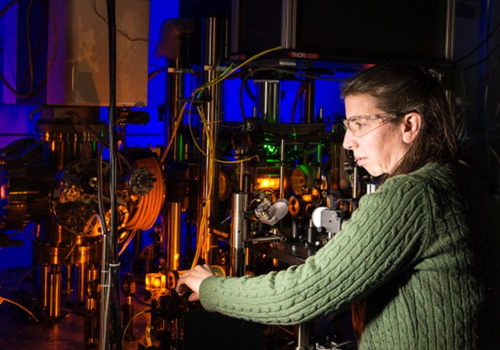Q&A: Things You Can Do with a Loop of Cold Atoms
When Gretchen Campbell entered graduate school in 2001, Bose-Einstein condensates (BECs) were still a novelty. Today, says Campbell, an atomic physicist at the Joint Quantum Institute (JQI) of the University of Maryland and the National Institute of Standards and Technology (NIST), researchers have moved beyond exploring the properties of these extremely cold collections of atoms, which behave like giant quantum waves. Instead, they’re using BECs as tools to study other kinds of physics. In Campbell’s field of atomtronics, for example, scientists are manipulating BECs with light to engineer systems that mimic transistors and other circuit components, or function as entirely new devices. The group she leads at the JQI has fabricated and studied a tiny ring of BEC intercepted in one spot by laser light that acts as a barrier for the atoms. Rotating this spot around the ring causes the system to behave like a superconducting quantum interference device, or SQUID, a sensitive detector of magnetic fields. Campbell, who initially wanted to be a vet, spoke with Physics about what attracted her to atomic physics and the many experiments that she’d like to try with ring-shaped BECs.
–Jessica Thomas
How do you describe atomtronics to someone outside of physics?
One of the properties of ultracold atoms is that they behave as a superfluid. People have proposed that it’s possible that we could use this superfluid behavior to create circuits, in which the atoms take the place of electrons. There have been some proposals to create analogs of conventional electronics. Others say, hey, let’s take advantage of the qualities of ultracold atoms that are distinct from electrons and see if we can make new types of devices and sensors.
What are these distinct qualities?
Since BECs behave as a superfluid, this means that if we create currents in our atomtronic circuits, they will persist, in much the same way that a superconducting current will persist in a loop of superconducting wire. Now, with BECs you have coherence, which you wouldn’t have in, say, a conventional electronic system. We also have the advantage that we can control the internal states of the atoms.
I take it there aren’t any practical atomtronics devices in existence yet?
Yeah, not at all.
If you had to guess, what do you think the first one might be?
I don’t really know. We’ve demonstrated a proof-of-principle rotation sensor: In our ring-shaped device, the current of the BEC will change when the rotating laser spot reaches a critical rotation rate. The rate associated with this transition will shift if the BEC itself experiences a rotational acceleration, so measuring the shift allows us to measure rotation. But because our device is so small—the rings are only 100 micrometers—it’s perhaps best suited for measuring changes in acceleration on a very small length scale. One always hopes that down the road there will be a practical application, but right now I’d say atomtronics is completely driven by fundamental physics.
What inspired you to dive into atomtronics?
A lot of my group’s studies were inspired by conversations with Chris Lobb, an experimentalist at the JQI who studies superconductors. In many ways, our superfluid system, in which atoms flow with almost zero viscosity, behaves analogously to superconductors, materials in which electrons flow with zero resistance. We’d like to understand how far that analogy goes and if there are things we’re able to do in our cold-atom system that are really hard to do in a superconducting condensed-matter system.
What are you working on now?
Most recently, we’ve been taking our BEC ring and increasing its [radius] very quickly—faster than the speed of sound. This supersonic expansion creates phonon-like excitations in the BEC, which thermalize and redshift as the ring expands. Theorists at the University of Maryland have said that this system could perhaps be used to study the behavior of the quantum fields associated with the expanding early Universe, and the quantum fluctuations of these fields. We’ve been playing around with ideas like that.
If you could wave your magic wand and do any experiment, what would it be?
There have been proposals saying that with a 1D ring of tunnel junctions in a BEC you could create interesting macroscopic quantum superposition states, where the atoms rotate both clockwise and counterclockwise. If we could create a lattice of barriers in our ring that were actually tunnel junctions, that would be a really neat system to study.
How did you catch the AMO bug, and what has kept you interested?
I went to a small liberal arts college (Wellesley) and had a fantastic advisor there. When I became interested in research he connected me with the summer undergraduate program at NIST in Gaithersburg. I spent two summers there, working in the laser-cooling and trapping group.
From the beginning I loved it. I like doing tabletop physics, but complicated tabletop physics. I like the mix of things you get to do. There’s vacuum technology, there’s lasers and optics. Every day is different. Some days I’m a plumber, some days I’m an electrician, and on a good day I get to do some science.
Know a physicist with a knack for explaining his or her research to others? Write to physics@aps.org. All interviews are edited for brevity and clarity.





